NASA with the help of SpaceX launched the first Imaging X-ray Polarimetry Explorer (IXPE) satellite in the equatorial orbit last week (December 9, 2021).
The purpose of the IXPE satellite will be to study the laws of nature on astrophysical objects that we humans cannot recreate in labs here on planet Earth. These objects include the remnants of supernova explosions like neutron stars, black holes, and pulsars.
SpaceX sent the NASA IXPE satellite to equatorial orbit using its Falcon 9 reusable rocket booster from the Launch Complex 39A at the Kennedy Space Center in Florida. This is the first NASA Launch Services Program (LSP) mission being launched from the launch pad 39A.
The IXPE mission is SpaceX’s fifth NASA LSP science mission after the:
- Double Asteroid Redirection Test (DART) Mission launched a few weeks ago (2021)
- Sentinel 6 Michael Freilich Mission (2020)
- Transiting Exoplanet Survey Satellite (TESS) launched in 2018
- Jason 3 Mission (2016)
The specialty of this mission is that the IXPE x-ray vision satellite is launched into the equatorial orbit with a 0° inclination. At an altitude of about 600 km (373 miles) along the equator of the planet Earth.
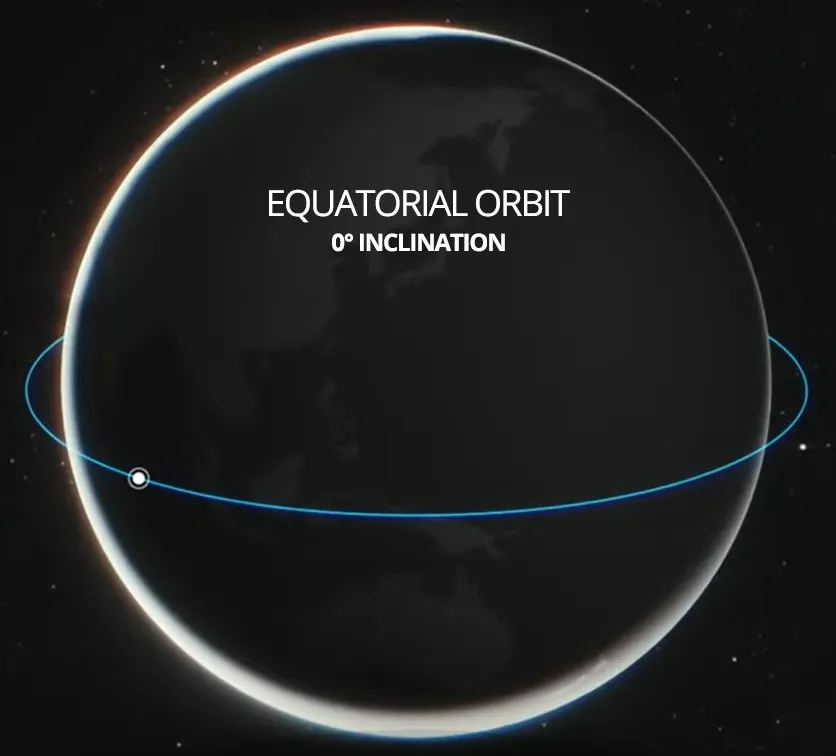
Let’s go over the details of the Falcon 9 rocket used in this launch then we will discuss the IXPE satellite in detail below with the recorded SpaceX webcast video of this event.
Since this is a long read, you might want to jump to a section that interests you the most:
IXPE Mission Falcon 9
This was the 5th flight of this specific Falcon 9 rocket booster used in the NASA IXPE satellite launch. This Falcon 9 is SpaceX’s 2nd flight-proven launch vehicle for NASA’s Landing Services Program (LSP).
This Falcon 9 booster first flew in November last year (2020). Since then, it has carried 3 Dragon spacecraft and 8 astronauts to the International Space Station (ISS). The Crew 1, Crew 2, and the CRS-23 missions. It also launched the Sirius XM8 (SXM-8) satellite to orbit on June 06, 2021.
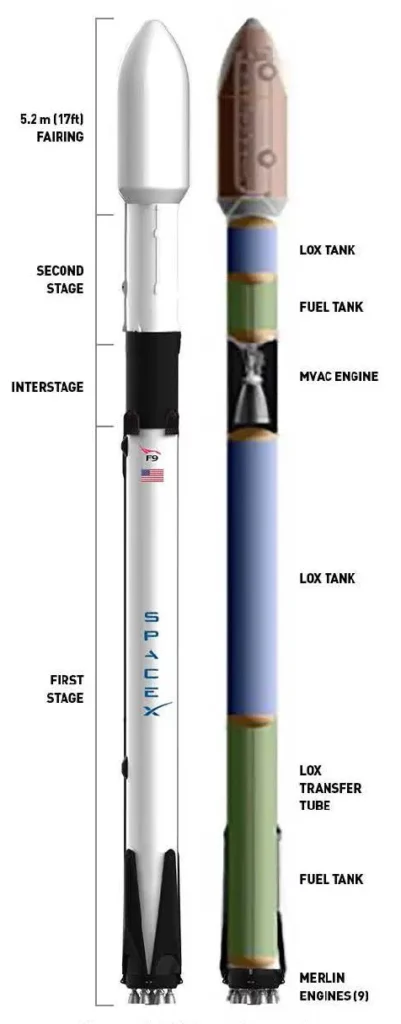
First Stage
As we can see in the above diagram, the bottom 2/3 segment of the Falcon 9 is referred to as the first stage. The first stage consists of three parts, the top one is the liquid oxygen (LOX) tank, the bottom is the fuel tank, and at the base, it has 9 Merlin 1D engines installed. The rectangular black covers above the Merlin engines are the first stage grid fins of the rocket booster that are opened just before it lands back on Earth.
The primary purpose of the first stage is to accelerate all the way to the edge of space with the help of 9 Merlin engines thrusting downwards.
Since reaching the equatorial orbit requires a lot of rocket performance which takes most of the propellant (LOX/RP1) getting burnt. With the lack of enough prepollent on its way back, SpaceX did not attempt to land the Falcon 9 back on the landing pad this time. Instead, the Falcon 9 first stage successfully landed back on SpaceX‘s autonomous drone ship named Just Read the Instructions stationed off the coast of Florida.
Interstage
The interstage is the relatively smaller back carbon fiber segment above the first stage (see Fig 2 above). This is the segment of Falcon 9 which houses the single Merline vacuum engine (MVac) that provides thrust for the second stage and the payload when the vehicle reaches space.
Second Stage and Fairing
The part of the Falcon 9 that starts above the interstage till the nosecone structure (fairing) is called the second stage (see Fig 2 above). The second stage consists of two containers, a fuel container (lower portion), and a liquid oxygen container (upper portion). These tanks provide the fuel for the Merlin vacuum engine in space to put the payload into the required orbit, in this case, the IXPE satellite into the equatorial orbit.
The Falcon 9 fairing is a shell made of two halves. This fairing cover protects the payload from the aerodynamic heating load and contamination during the ascent phase of the mission.
To rescue the fallen fairing halves, SpaceX stationed its IXPE mission fairing halves recovery ship named Bob in the Atlantic Ocean.
Fuel, Oxidizer, and Igniter
The Falcon 9 rocket is a bi-propellant launch vehicle. There are two propellants on board. A fuel and an oxidizer. Falcon 9 uses a refined form of kerosene which is called RP-1 (Rocket Propellant 1). When fully loaded, the first and second stage Falcon 9 combined fuel is over 1.1 million pounds of RP-1 propellant.
To burn this fuel, an oxidizer is needed. SpaceX uses super-chilled liquid oxygen (LOX) called densified LOX.
Liquid oxygen is chilled well below its boiling point which increases its density which allows for increased loading of the oxidizer onto the first and second stage LOX tanks (see Fig 2 above).
On Earth, rocket engine combustion uses oxygen from the air as its oxidizer. This oxygen makes up about 21% of the air that humans breathe. In space, there is no atmosphere to provide this oxygen or other oxygen-bearing molecules, so the rockets need their own onboard.
An igniter chemical is needed to burn the fuel and oxidizer. SpaceX uses a chemical combination called T-TEB (Triethylaluminium + Triethylborane). When these chemicals are combined, the reaction produces a characteristic of green-green flash that is sometimes visible at the base of the vehicle when the Merline engines are ignited.
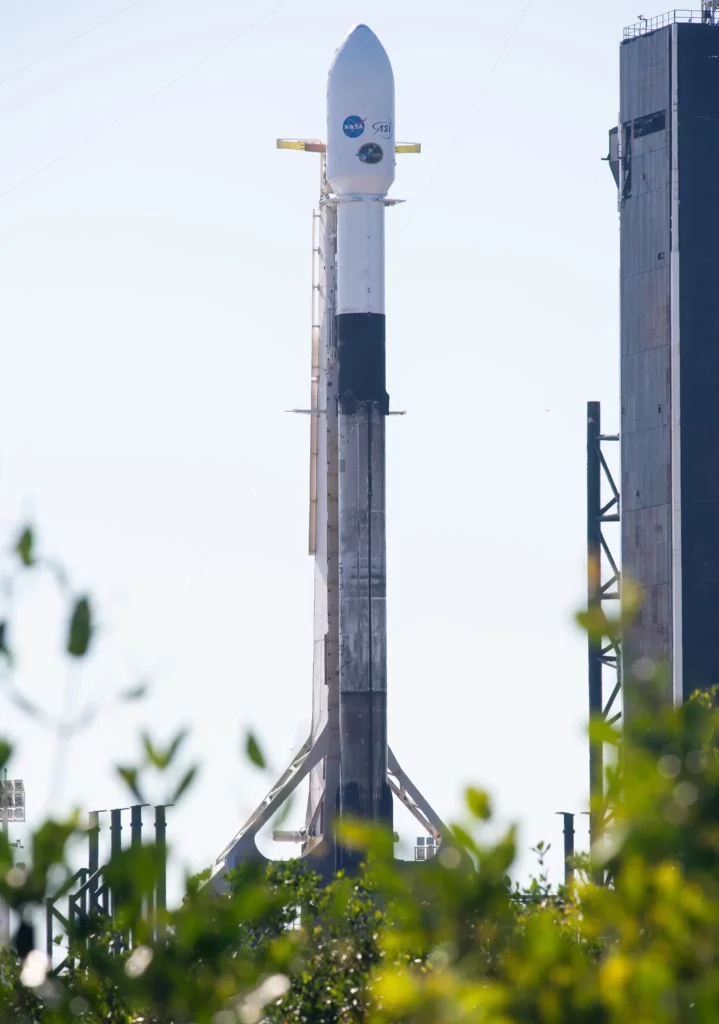
IXPE Satellite
Purpose
The NASA IXPE (Imaging X-ray Polarimetry Explorer) satellite is an orbital observatory that will study the uncharted objects of the universe like black holes, neutron stars, pulsars, supernova remnants, and beyond.
The prime IXPE mission is going to span over the next two years. In this period, the NASA IXPE satellite will observe more than 50 billion objects from deep space. For example, the leftovers of huge stars that exploded into supernovas and the super-massive black hole that exists at the heart of our own Milky Way galaxy.
IXPE will look at a special property of these gigantic and ultra-magnetic objects that has largely gone unexplored until now — it is called polarization (explained below).
The observations by IXPE will help scientists solve longstanding puzzles of the universe like testing competing theories about pulsars. According to NASA, this will also help study the details of Einstein’s Theory of General Relativity.
New insights from IXPE will also help us paint a fuller picture of the Universe, either confirming or confounding our thinking in the years to come.
NASA
How IXPE Works
The IXPE observatory has 3 identical telescopes or Mirror Module Assemblies (MMA) with three main parts each; mirrors, detector, and an extendable mast or boom that separates them (see Fig 3 below). Each mirror assembly contains 24 nested mirrors that collect and focus x-rays.
Sensitive imaging detectors located at the focal points of these mirrors are the secret behind IXPE’s unique x-ray vision. NASA has partnered with suppliers in Italy to make these high-tech imaging detectors.
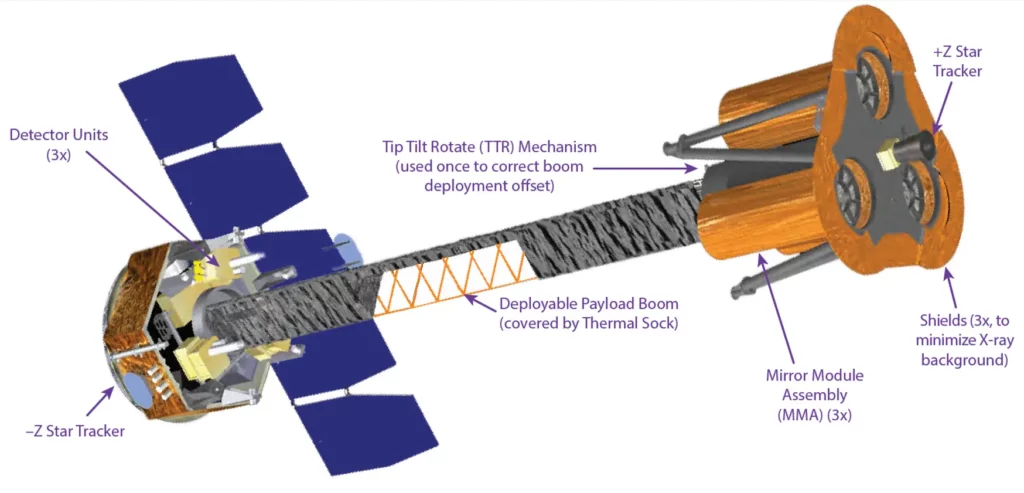
X-rays come from the hottest places in the Universe. Such as powerful explosions, violent collisions, and strong magnetic fields creating energy in the darkness of the deep space. X-ray telescopes can trace clouds of gas, heated to millions of degrees and detect the shower of particles fueled by a feeding black hole.
Like all forms of light, x-rays consist of moving electric and magnetic waves. Usually, the peaks and valleys of these waves move in random directions. Polarized light is more organized with the two types of waves vibrating in the same direction.
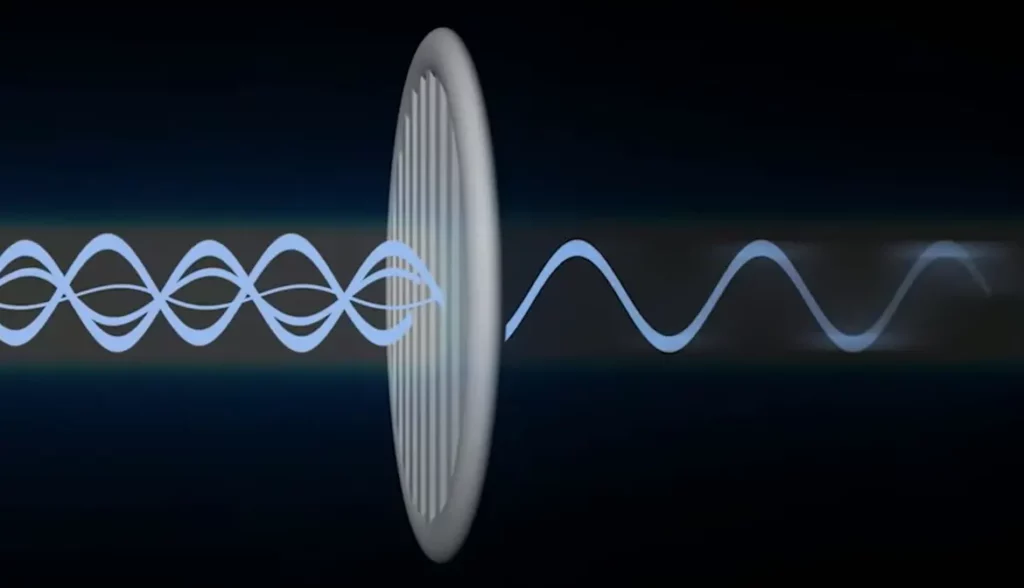
An example of light polarization filtering is the polarized sunglasses that boaters and fishermen use. These lenses reduce the glare of sunlight across the body of water.
Water reflects light in a way that causes some of it to vibrate in a direction parallel to the water surface. Polarized lenses block the light that is moving horizontally but let other light through.
Much like the way light bounces off of water, in space, light becomes polarized depending on where it is coming from and what it passes through.
By measuring the amount and direction of polarization, IXPE gives us clues about the shapes, structures, and inner workings of all types of objects that shine in bright x-rays.
IXPE’s Mirror Module Assemblies (MMAs) measure all four properties of incoming light — its arrival time, direction, energy, and most importantly polarization.
The Launch
The IXPE satellite aboard the SpaceX Falcon 9 rocket was launched on December 9, 2021 (1:00 AM EST / 6 AM UTC). As the launch approached T minus 0 mins, the ground hydraulic system pulled the transporter erector away from the Falcon 9 rocket booster as it proceeded into its liftoff.
SpaceX also refers to the Falcon 9 transporter erector (TE) as Strongback. A transporter erector is used to roll out a rocket to the launch pad and raise it into the vertical launch position. The Falcon 9 TE also routes power, fluid, and communications to both the rocket and the satellite.
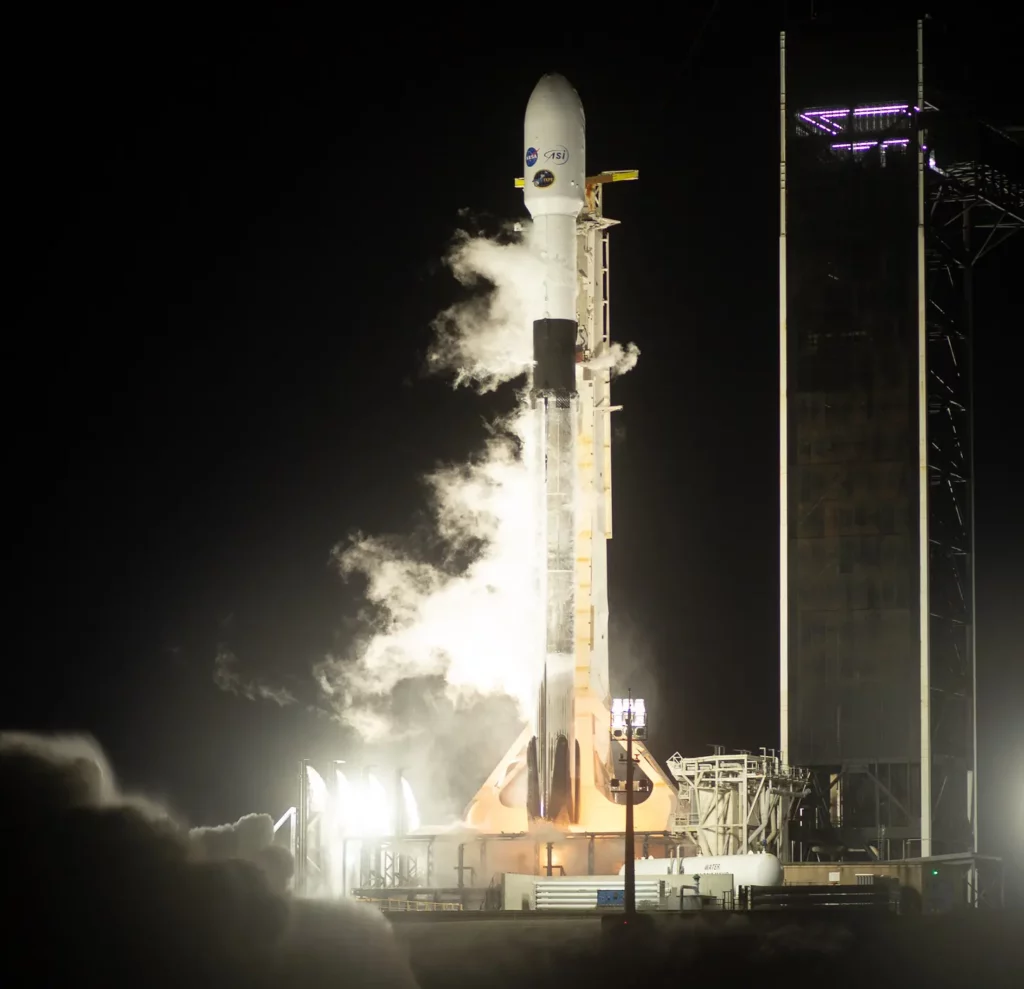
The fumes or white gas around the rocket before the launch is from the chilled liquid oxygen and periodic venting around the vehicle (see Falcon 9 pic above). When chilled LOX chambers come into contact with the moist Florida air, it causes the water vapors to condense and form literal clouds around the vehicle.
At T – 60 seconds (1 minute before liftoff), Falcon 9 transitions to internal control via its autonomous flight computers. Falcon 9 takes over the launch countdown. Then it continues to have control of Falcon 9 through the rest of the mission after the launch directors give their final go for the launch — if all conditions continue to look good.
At T – 2 seconds, the Falcon 9 flight computers ignite all the 9 Merlin 1D engines on board. After two minutes 41 seconds into the flight (T + 00:02:41), the first stage separation event took place just after the main engine cut off (MECO) when all the 9 Merlin sea-level engines were shut off.
Fairing halves were separated at an altitude of 109 km (67.72 miles). Atmospheric density at this altitude is very low, so the fairing cover is not needed anymore. Removal of the fairing cover at this stage exposed the IXPE satellite to space.
After a few seconds, at T + 2 mins 47 seconds, the Merline vacuum-level engine (MVac) on the 2nd stage was ignited, the phenomena known as second engine start (SES) #1. This first engine firing took the IXPE satellite to its initial parking orbit at an inclination of 28°.
At T + 8 mins 12 seconds, the second stage Merlin vacuum engine was cut off as the vehicle reached the initial orbit. To place the IXPE satellite into the equatorial orbit, a second engine firing took place about 20 minutes later i.e. at T + 28 mins 55 seconds to be exact.
The final MVac thrust helped reach the second stage and the IXPE satellite to reach the equatorial orbit. The IXPE satellite payload was deployed to the equatorial orbit at 0° inclination at around T + 33 mins. This puts the IXPE satellite into a 600 x 600-kilometer circular orbit above the equator.
Let’s watch the entire SpaceX Falcon 9 IXPE mission live webcast recording for a visual experience.
Stay tuned for future updates on Starship and SpaceX, Follow us on:
Google News | X (Twitter) | Flipboard | WhatsApp Channel | RSS (Feedly).


